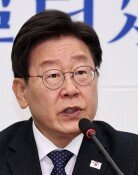Hyundai opens centers to compare its cars with imports
Hyundai opens centers to compare its cars with imports
Posted March. 21, 2012 13:24,
Imported cars such as Mercedes Benz and Lexus were seen parked at Hyundai Motors central test driving center on Hangang-ro street in Seoul`s Yongsan district Tuesday. They were vehicles for comparative test driving that Hyundai offered to customers from the date.
Curious passers-by wondered why foreign cars are parked at the Hyundai Motor dealership. The site started to get crowded with people who wanted to test drive the cars there from the afternoon.
Hyundai Motor launched Tuesday a comparative test driving center with imported cars at seven major branches nationwide, including those in the Seoul districts of Gangnam, Yongsan and Jamsil, Bundang, Incheon, Busan and eastern Daegu. Anyone can use the service by checking the vehicles available for test drive on Hyundai Motors Web site and making a reservation by phone.
The test driving centers have on standby five Hyundai models -- Genesis, Grandeur, Sonata, i30 and Veloster -- and six imported models -- BMW 528i, Mercedes E300, Lexus ES350, Toyota Camry 2.5, Volkswagen Golf 1.6 TDI, and Mini Cooper SE. The imports are all latest models that Hyundai Motor rented from car rental companies through February next year.
The company plans to replace the imports when their replacement models are introduced. The standing facilities for comparative test driving are something unprecedented in Koreas car industry.
The test driving centers were installed at the suggestion of Hyundai Motor President Kim Choong-ho, who once headed the automakers domestic marketing and sales. He proposed the installation of the centers, saying We don`t lag behind imported cars in any aspect but have been behind in efforts to demonstrate it. Kim said he made a bet with strong confidence in Hyundais quality and value, which he said have significantly improved in recent years.
The move was also part of the company`s efforts to check the expanding Korean market for imported cars. The market has shown exponential growth, with the number of foreign vehicles sold in Korea topping 100,000 units for the first time last year.
Analysts say the imported car market will continue to grow further in the wake of the effectuation of free trade agreements with the European Union and the U.S.
Another reason for the centers is consumer desire to test-drive vehicles before buying. A survey of 800 buyers of full-size sedans conducted from Jan. 20 to Feb. 19 found that consumers agonize over two models on average when buying a new car. Buyers aged less than 44 go on test drives before making a choice.
Timed with the launch of the comparative centers, Hyundai started training its sales staff on comparison of imported cars with Hyundai models. The automaker will expand training to cover its 70 branches nationwide by the end of May.
Hyundai Motor also published and internally distributed the book The Truth About Imported Cars, which compares performance, fuel economy, price and repair costs between Hyundai and foreign models. This was intended to enable sales staff to comparatively explain in detail the Hyundai difference to customers.
An auto industry source said, The operation of the comparative test driving centers simultaneously displays Hyundais self-confidence in its vehicles and a sense of crisis.
gene@donga.com







